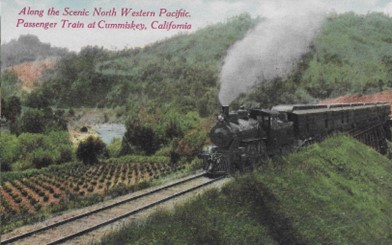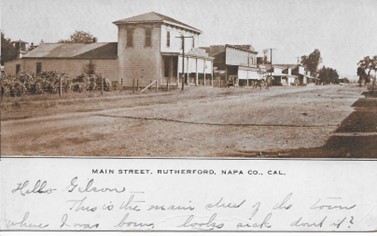Including the “Beautiful California :: Wine Industry” series, there are some two dozen postcards in my California Wine Country collection that can be identified as Turrill & Miller photographic images — all are in Sonoma or Napa counties. Also, there are probably another dozen or so not bearing a Turrill & Miller imprint that could well be from their camera. The California Pioneers online video “survey” titled “An Escape to Wine Country” presents about three dozen images; it is not clear how many became postcards. There are about twice as many Napa images (29), and I have fifteen of them as known postcards. A thorough survey of the T & M photographic wine country archive (550+images) at the Society would be a valuable endeavor. In the meantime, traveling first to the Sonoma County area, here is a fine showing, with good stories.
— Sonoma Wine Country —

Wine Cellars, Italian Swiss Colony, Asti, 1906-07
Arriving through the lush foreground vineyard, we have a gorgeous view of the Asti winery complex founded in 1881. The impressive winery building was constructed in 1887, and the first vineyards were planted several years earlier to Zinfandel, 150 acres in two years. When Turrill & Miller arrived for their photographic visit, the vines covered the rolling terrain as far as the eye could see. Touted as the largest winery in the world — and the best known — ISC made one out of every three bottles of California wine and had been honored at every notable Exposition worldwide since 1892.

Korbel Vineyards on Russian River, near Guerneville, 1906-07
Another exceptional, well-thought-out, popular photograph by Turrill & Miller captures the railroad tracks of the Guerneville branch of the N.W.P.R.R., the winery buildings in the background amongst the trees, and on the right, a section of vineyard with still lingering massive redwood stumps. The postcard has three known “editions.” This brown-toned sepia card was issued by Edward Mitchell, a prolific S.F. postcard publisher who was one of the earliest and most productive postcard publishers in America. No hand-colored version has yet been seen. Still hopefully searching. I love this postcard. [For more on Korbel, see “Russian River Wine Lore at Korbel.”]

Vineyards at Pieta and Cummiskey Stations, 1906-07 — Pieta Station, On the North Western Pacific R. R., 1906-07
So, how long does a photographer patiently wait for a scene like this to develop? Pieta Station, complete with a siding and several buildings (including a P.O. from 1891–97), was located just north of the Sonoma County line on the west side of Pieta Creek and the Russian River, about 10 mi north of Cloverdale. Passengers transferred here to stages for Lake County to the east. In this “perfect” postcard view set against a background vineyard, “Inspection Car No.01 is in the Pieta siding, as a freight train approaches in the far distance. The two men in suits are probably railroad officials,” explains railway aficionados Codoni & Trimble in their Northwestern Pacific Railroad (2006). Just south of Pieta Station was Cummiskey Station, a railroad siding with one building and a stage stop used by the local ranchers. These are spectacular wine country images.

Passenger Train at Cummiskey, On the North Western Pacific R. R., 1906-07
The small railway depots at Pieta and Cummiskey were important for the local ranchers and vineyardists and often provided overnight accommodations for travelers. The prominent Pieta Ranch was founded by Anthony De Marcantonio in 1921, a decade later than these photo postcards. The story goes that he demolished the then obsolete railroad buildings and planted a vineyard. Another decade passed, Prohibition was ending, and he built the rousingly popular Pieta Tavern on Highway 101. Every midnight he served ravioli, meatballs, French bread and butter, and a glass of wine to the revelers — for the price of 25 cents. Cheers!
— Napa Wine Country —
![Unloading Grapes at Winery, Napa [Eshcol Winery], 1906–07 Unloading Grapes at Winery, Napa [Eshcol Winery], 1906–07](https://i0.wp.com/winehistoryproject.org/wp-content/uploads/2024/03/Picture5-1.jpg?resize=389%2C243&ssl=1)
Unloading Grapes at Winery, Napa [Eshcol Winery], 1906–07
The unidentified large, handsome wooden winery featured in this rare sepia postcard was built in 1886 by the Goodman brothers, founders of the first bank in Napa City. They called it Eshcol, from the Biblical story of the giant cluster of grapes requiring two men to tote it. The Goodmans had acquired the mid-valley parcel in 1875, once a part of Joseph Osborne’s award-winning Oak Knoll Ranch. Designed by acclaimed Napa Valley winery architect H. W. McIntyre, it is today the only remaining example of a Napa Co. 19th century three-level gravity flow winery constructed entirely of wood. Eshcol was acquired in 1968 and painstakingly restored by the Trefethen family, who continue to run the historic property. There is a companion full-view Turrill & Miller image of the building captioned “No.45N. Eschol Winery, Napa Co.” (name misspelled). It is also a sepia card published by Pacific Novelty Co., and exceedingly hard to find. Sullivan’s Companion, p.369 has a picture.

California Wine Industry, Entrance to Greystone Winery, 1906–07
It is amazing to me that of the total 140 postcards in my Greystone/Christian Bros section, there are nearly thirty postcard views of the stone arch gateway (equally divided between Pre- and Post-Prohibition eras). This beautiful Turrill & Miller view is my overwhelming favorite. Now that I know the story of their 1906–1907 photographic visits, no longer need I wonder about the archway boulder in the roadway — it surely tumbled during the 1906 earthquake. Such a wonderful, historic photographic postcard record.
![Jacob & Grimm’s [sic] Winery. Underground. Calistoga, 1906–07 Jacob & Grimm’s [sic] Winery. Underground. Calistoga, 1906–07](https://i0.wp.com/winehistoryproject.org/wp-content/uploads/2024/03/Picture7-1.jpg?resize=376%2C236&ssl=1)
Jacob & Grimm’s [sic] Winery. Underground. Calistoga, 1906–07
This Turrill & Miller image of Jacob Grimm Winery is a true wine country postcard treasure. It was published by C.W. Armstrong, Calistoga Druggist (and postcard vendor), while it carries a very early 1908 Calistoga postmark sending home the message, “This is where we were last Wednesday.” While T & M were at the Grimm Winery, they also took several photos around the winery, showing the wine press and fermenting vats, a cluttered rear work area, and grapes in the vineyard. Jacob Grimm planted his vineyards high in the hills four miles above Calistoga in 1883 and had his wine-aging cellars dug into the mountain in 1889. His family revived the operation for a brief time after Repeal, but the real revival came in 1979 as Storybook Mountain Cellars, founded by new owner Bernard Seps.

U.S. Special Bonded Warehouse Nr.3, St. Helena, 1906–07
We should be forever grateful to Turrill & Miller for this extremely rare, historically invaluable postcard image. It was published by Joe Galewsky, “St Helena’s Leading Stationer & Headquarters for Postcards,” as part of an extraordinary series that we will explore further on a future visit. These cards all have a descriptive very-rare-at- the-time back caption, as this one: “Wine making is one of the chief industries of St Helena. Brandy is also made in large quantities. This picture shows the Government Store House for Unstamped packages of brandy.” More on the story: In 1878, in order to provide U.S. government bonded storage for grape brandy, the St Helena Warehouse Assn. was formed by local viticultural pioneers Krug, Thomann, Beringer Bros, Weinberger, Scheffler, Lewelling et al. With $10,000 in capital the large stone warehouse was built on Church Street just south of Hunt, near the railroad depot. As the distilling industry grew, the original 35′ x 60′ facility was enlarged twice to 105′ x 135′. Small note: The postcard front caption states Bonded Warehouse Nr.3; the St Helena Star reports Nr.13.

Tubbs Winery, Calistoga, 1906–07
When Turrill & Miller masterfully photographed this imposing stone wine cellar with its towers and turrets, it was known as Tubbs Winery. Twentieth century wine historian Charles Sullivan called this historic winery one of Napa Valley’s most important. Founded in 1882 by Alfred Tubbs (of 1850s’ S.F. Tubbs Cordage fame), he named his magnificent wine estate Hillcrest. Following Prohibition his grandson Chapin re-opened the winery as Chateau Montelena after nearby Mount St Helena. In 1972 Mike Grgich became winemaker; in 1976 the Paris tasting occurred, the ‘73 Montelena Chardonnay won the prize, and lasting importance and fame descended upon them.

Main Street, Rutherford, Napa Co, 1906–07
A noteworthy collection of non-winery scenes are also cherished images in my postcard archive. These cards recall the towns and countryside where wine families lived and worked and sometimes played. It is joyous to recognize those by Turrill & Miller, usually favorites. Take this T & M view of Rutherford. Vines growing at the end of town, the highway running north & south. Rutherford, and its close southern neighbor Oakville, are two small but important wine towns between St Helena and Yountville, and always have been. Beginning in 1879, when Capt. Niebaum founded Inglenook, Rutherford has been home to prized winery landmarks, including nearby Valley View Winery, which became Beaulieu in 1915. Sadly, our postcard sender Emma Randall did not share our enthusiasm for her town: “This is the main street of the town where I was born, looks sick don’t it?” Born in 1864 into the pioneer Steckter farming family, she married Charlie Randall in 1888 and was finally living in Oakland when she wrote this card at age 47. Bless her heart.

County Road to St. Helena, Cal., 1906–07
Over a period of fourteen months, our photographers wandered these roads and byways of a wine country like no other. And they graciously recorded its beauty and history for us to treasure more than a century later. Thank you, Turrill and Miller.




